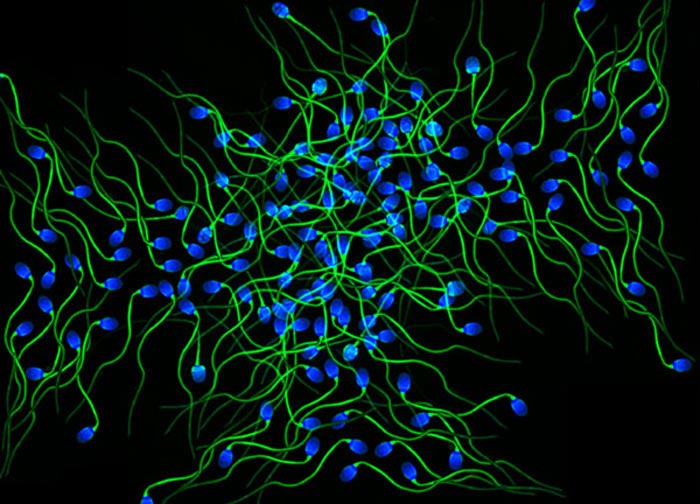Girdin one’s loins

A fluorescence micrograph of isolated human sperm cells, taken by Albert Tousson, 2002 Nikon photomicrography contest winner.
Credit: UC San Diego Health Sciences
Researchers identify a key protein that helps sperm do their job in timely fashion, a discovery with implications for treating male infertility—and perhaps male birth control.
Mammalian sperm cannot fertilize an egg from the get-go. It’s an ability acquired only after insemination, during passage through the female reproductive tract, and requires two consecutive, time-sensitive processes to provide sperm with the physical and biochemical traits necessary to complete their fundamental job.
The first process is called capacitation, which alters the physiology of each spermatozoa, changing the membrane of the head to help it penetrate the hard, outer layer of an egg — the zona pellucida — and chemistry in the tail to generate greater motility, the ability to move and swim.
The second process is acrosome reaction (AR), a chemical action that involves releasing enzymes in the spermatozoa’s head that further boost penetration of the zona pellucida.
Both processes are essential to successful fertilization of an egg, and AR is time-dependent: It cannot take place too early or too late. Indeed, premature AR has been associated with idiopathic (spontaneous) male infertility.
Neither process, however, is well understood in terms of the underlying molecular mechanisms involved. In a new paper, publishing August 19, 2021 in the journal eLife, a team of researchers at University of California San Diego School of Medicine detail how GIV/Girdin, a ubiquitous signaling molecule plays a critical role in male fertility, orchestrating capacitation and AR to promote sperm motility, survival and fertilization success.
Specifically, the research team, led by senior author Pradipta Ghosh, MD, professor in the departments of Medicine and Cellular and Molecular Medicine at UC San Diego School of Medicine, found that GIV—a member of the G protein family that serve as molecular switches inside cells, transmitting and fine-tuning signals—regulates the activity of enzymes that turn on and turn off the processes of capacitation and AR.
“The findings demonstrate how GIV orchestrates distinct signaling programs in sperm that separated by space and time, effectively supporting capacitation while inhibiting premature AR,” said Ghosh. “As a result, GIV plays an essential role in male fertility.”
Infertility affects an estimated 8 to 12 percent of couples globally, with males being a primary or contributing factor in roughly half of all cases, according to published studies. Causes of male infertility are multiple, but roughly 25 percent involve either sperm transport disorders or idiopathic factors in sperm with no apparent dysfunction.
“GIV is required for male fertility, and low levels of GIV transcripts in men is invariably associated with infertility,” said Ghosh. “We’ve found evidence that GIV may perform different roles in the capacitation of sperm, findings that shed new light on both how defective GIV-signaling might be used as a potential marker for male infertility and how inhibitors of GIV-dependent signaling inhibit fertility by reducing sperm motility and viability and by promoting premature acrosome reaction.
“The latter, ironically enough, may be a promising strategy for development of a male contraceptive pill specifically targeting sperm.”
Co-authors include: Sequoyah Reynoso, Vanessa Castillo, Gajanan D. Katkar, Inmaculada Lopez-Sanchez, Sahar Taheri, Celia R. Espinoza, Christina Rohena, Debashis Sahoo and Pascal Gagneux, all at UC San Diego.
Method of Research: Data/statistical analysis
Article Title: GIV/Girdin, a non-receptor modulator for Gαi/s, regulates spatiotemporal signaling during sperm capacitation and is required for male fertility
Article Publication Date: 19-Aug-2021
Media Contact
Scott La Fee
slafee@ucsd.edu
Office: 858-249-0456
All latest news from the category: Life Sciences and Chemistry
Articles and reports from the Life Sciences and chemistry area deal with applied and basic research into modern biology, chemistry and human medicine.
Valuable information can be found on a range of life sciences fields including bacteriology, biochemistry, bionics, bioinformatics, biophysics, biotechnology, genetics, geobotany, human biology, marine biology, microbiology, molecular biology, cellular biology, zoology, bioinorganic chemistry, microchemistry and environmental chemistry.
Newest articles

Innovative 3D printed scaffolds offer new hope for bone healing
Researchers at the Institute for Bioengineering of Catalonia have developed novel 3D printed PLA-CaP scaffolds that promote blood vessel formation, ensuring better healing and regeneration of bone tissue. Bone is…

The surprising role of gut infection in Alzheimer’s disease
ASU- and Banner Alzheimer’s Institute-led study implicates link between a common virus and the disease, which travels from the gut to the brain and may be a target for antiviral…

Molecular gardening: New enzymes discovered for protein modification pruning
How deubiquitinases USP53 and USP54 cleave long polyubiquitin chains and how the former is linked to liver disease in children. Deubiquitinases (DUBs) are enzymes used by cells to trim protein…



